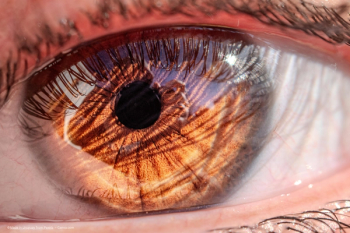
Rates of change may signal POAG
Analyses of data from the Confocal Scanning Laser Ophthalmoscopy Ancilliary Study to the Ocular Hypertension Treatment study found rim area parameters changed significantly in the eyes that had progression to a primary open-angle glaucoma endpoint compared with eyes that did not.
Seven of the 22 OHTS study centres participated in the CSLO Ancillary Study. Patients enrolled at these centers had annual exams using a tomography platform (Heidelberg Retina Tomography-1 [HRT-1], Heidelberg Engineering). The acquired images were processed with software (HRT 3.0 version or higher) at the University of California, San Diego (UCSD) reading centre.
Rate of change was analysed for a number of HRT parameters, including rim area, percent of baseline rim area, rim:disc area ratio, cup volume, retinal nerve fibre layer (RNFL) thickness, RNFL cross-sectional area and glaucoma probability score (GPS). Change was faster in the rim area parameters, cup volume and GPS in eyes that developed POAG than in those that did not. There were no significant differences between the two groups of eyes in the rate of change of RNFL parameters.
Measuring change
Analyses presented were based on data from 441 patients (869 eyes) with good-quality CSLO exams. About 17% of the patients were African American. During follow-up, 52 patients (66 eyes) developed POAG based on rigorous OHTS visual field and/or optic disc stereophotographic criteria.
For the eyes with POAG, median follow-up was 5.6 years to the time they reached the diagnostic endpoint (maximum 12 years) while the median available follow-up for the eyes that did not develop POAG was 11 years (maximum, 14 years). Of the patients who had progression to glaucoma, about two-thirds were diagnosed on the basis of reaching an optic disc deterioration endpoint only. During ongoing follow-up, about one-fourth of patients developed both optic disc deterioration and visual field abnormalities.
The analyses of rate of topographic optic disc changes were performed using multivariable mixed effects models to compare the slopes of changes in individual HRT parameters over time in eyes that did and did not develop POAG. The covariates included in the model were race, randomization to treatment and baseline age, central corneal thickness, stereophotograph-based horizontal cup:disc ratio, IOP, visual field pattern standard deviation and disc area.
Dr Zangwill focused on the rim parameters. Results from the multivariate models showed a 5-fold faster rate of loss in rim area in eyes that developed POAG compared with eyes that did not. Eyes that developed POAG also had a 4-fold faster rate of loss in the ratio of rim:disc area and a 7-fold faster rate of percentage loss of baseline rim area compared with their counterparts that did not have progression to glaucoma.
She proposed several possible explanations for the observation of significant changes over time in HRT parameters among eyes that did not undergo progression.
"These may represent normal ageing or early changes either not detected by conventional methods of optic disc or visual field evaluation or that were not considered clinically significant or fulfilling the protocolspecified endpoint criteria for POAG diagnosis," she continued.
"The OHTS endpoints for diagnosing POAG required reproducible optic disc or visual field changes and the endpoint committee made the final determination of whether changes were clinically significant and attributable to POAG," she added. "However, 55% of the reproducible optic disc changes recorded in OHTS participants were not considered a POAG endpoint by the endpoint committee."
Considering eyes that developed POAG, the rate of change in rim area appeared faster in African Americans compared with other OHTS participants. However, in the multivariable random effects models including disc area by time, race by time was no longer a significant predictor. This indicates that the race relationship with rate of change in rim area may be explained in part by the larger disc size in African Americans.
"We have previously reported in the CSLO Ancillary Study to OHTS that there were racial differences in the baseline optic disc topography such that African Americans had significantly smaller rim:disc ratio and significantly larger optic discs, cups, neuroretinal rims and cup:disc ratios than other participants," Dr Zangwill emphasized.
"However, it was also shown that after adjustment for racial differences in disc area, none of the differences in optic disc topography between African Americans and other participants remained statistically significant," she concluded. "Other investigators have reported similar findings."
Newsletter
Get the essential updates shaping the future of pharma manufacturing and compliance—subscribe today to Pharmaceutical Technology and never miss a breakthrough.




